Voice over dictionary
As with any profession, the voice-over industry has its own jargon. So here's a little voice-over dictionary.
ABC
When a artistic director asks a French voice actor (or any voice actor) "could you please give me an ABC", he wants different takes (intentions, interpretations, etc.), one after the other.
Accent
We all have an accent, but to work as a voice over talent, you have to learn to mask it in order to achieve a 'neutral' accent. When you're working in a foreign language and you're not a native speaker, claiming to be able to do a native accent is misleading, dishonest and lands you on the prods' red lists. Being bilingual, I record voice overs in English with French accent but never claim to be a native. Do as I do.
Private agreement
Agreement on a rate directly between the client and the voice-over actor, outside the rates set by collective bargaining agreements (for dubbing and documentaries).
Title given to people whose job it is to lend their voice to advertisements, institutional films, documentaries, etc. - also called French voice actor. People who dub foreign films or series are called dubbers. Voice acting and dubbing are two different professions - of course, the same person can perform both professions with talent, but this is not always the case.
Ad lib
Voluntary addition to the script by the voice actor, particularly when playing a character (in audio book for example): while onomatopoeia rarely appear in written language, they are common in oral transmission, hence this 'adaptation' when the desired interpretation is 'conversational'.
That said, beware, it's not always appropriate - read the article Hands Off My Script for more details on what you can do (and, more importantly, what you can't do) with scripts.
Acronym for 'Automatic Dialogue Replacement' (which is funny, considering that the process is not automatic and does not replace dialogue!) - part of post-synchronisation.
This involves creating the sound atmosphere for film scenes involving people - restaurants, battle scenes, etc. Generally, only the main characters in a scene are recorded, so the sound atmosphere for that scene has to be created. This is done in the dubbing studio, with groups of actors. Sometimes it's also necessary to recreate an atmosphere that has been recorded, but which is unsuitable for X reason.
The word 'advertiser' refers to a customer who has commissioned an advertising campaign. It is rarely our client, and more frequently our client's client (and sometimes, our client's client, our client's client...).
This involves describing scenes from a film or documentary, for example, to a blind or partially-sighted audience. The tone must be neutral and free of emotion, without being soporific. It's a difficult exercise.
Sometimes, end customers don't have the experience and skills of a casting director to cast an actor on the basis of his demo, so they ask a panel of voice actors whose voices match what they want to perform a sample of their script: this is an audition.
We generally only hold auditions, which are time-consuming if we want to do them properly, for large projects that justify our investment of time, as auditions are generally unpaid.
Beware of auditions requested on voice-over portals or by clients who are not known in the profession: they sometimes ask to record the entire script, and become silent once the audition has been sent. Unscrupulous individuals sometimes use auditions for their own projects, without informing the actors...
Autopromo
Network promos are short films (usually less than 30s) that promote a film or programme broadcast on the same channel as the self-promo. Here's an example, with a MTV self-promo for Fast & Furious.
Trailer
Trailer - a short film promoting a feature film.
Rythmo Band
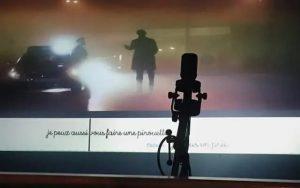
A horizontal strip at the bottom of the screen where the text to be dubbed scrolls, with a vertical bar in the middle indicating what needs to be said at the precise moment when the letters 'hit' this bar.
This allows lip-sync perfect, if the script has been correctly adapted to have the right number of plosives, fricatives etc... and the actor is good.
This is the preferred dubbing method in France, but you can also use the loop to achieve the same result.
Music and sfx - voice-over is also part of the soundtrack, but as far as we're concerned, we work on a soundtrack without voice-over, or with voice-over in the original language when we're localising a spot, film, game or animation.
Before a private studio session, make sure it is sent to you, so that you can work in harmony with it - I develop the subject in this article on wearing a helmet.
Billboard
Bumper' spots - often short spots sponsored by a brand, announcing the start and/or end of a programme such as this one for which I recorded the voice-over for Krupsfor example.
Brief
Instructions on the type of interpretation requested by the artistic director. When recording solo from your own private studio, we strongly recommend that you ask for these instructions by e-mail, so that there is a record of them.
Floor noise
‘Floor noise’ en anglais. Il s’agit du niveau de bruit de fond inhérent à la cabine et au système d’enregistrement (bruit électronique du micro, préamplis / convertisseurs, interférences électriques, ondes stationnaires…). Il s’exprime en -dB rms. Plus cette valeur est faible, mieux c’est.
Exemple : un bruit plancher de -80dB rms est meilleur qu’un bruit plancher de -60dB rms, ceci étant la valeur minimale acceptable pour un recording studio professional.
Comment calculer le bruit plancher de son studio ?
1/ lancez l’enregistrement dans votre DAW, au niveau auquel vous vous enregistrez, avec votre micro
2/ sortez de votre cabine, refermez la porte
3/ 2mn après, retournez dans votre cabine
4/ arrêtez le rec, top & tail les bruits de sortie et de retour dans la cabine
5/ allez dans l’audiosuite de votre DAW – s’il n’en a pas, ce n’est pas un DAW, changez-en
6/ cliquez sur GAIN
7/ sélectionnez la minute centrale de la prise
8/ cliquez sur RMS (pas sur PEAK), puis sur ANALYSER
Voilà, vous avez le bruit plancher de votre cabine
BSF
Acronym for 'Basic Studio Fee' - what we are paid per hour or per session. This fee does not include exploitation rights and/or compensation (if applicable).
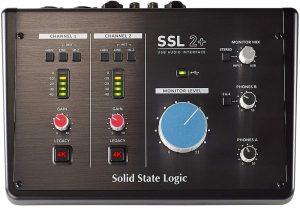
Sound card
This is an interface equipped with one or more preamps, which transforms an analogue signal - sound waves - into a digital signal so that it can be recorded on a computer to which it is connected.
Helmet
Also known as headphones, the headphones are worn by the voice-over actor during recording so that he can get instant feedback on his performance. Working with or without headphones? I develop the subject in my article Wearing a helmet is compulsory.
The process of selecting the voice-over actor(s) for a project. You can take part in castings on demoor on audition. I deal with this subject in my article Voice casting.
Compression
(I'm talking here about dynamic compression of a sound, not about reducing the size of a file by lowering its quality, for example by going from WAV to mp3).
Audio compression is used to control the amplitude of a signal, i.e. to manage the differences between the softest and loudest sounds in a sound source.
PLEASE NOTE: we are not sound engineerswho have been trained in their trade for several years. Just because the tools are available in any DAW doesn't mean you can play the sorcerer's apprentice. The best thing to do is to deliver 'raw' (unprocessed sound), and leave it to the professionals.
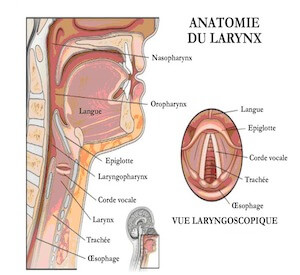
Vocal strings
Our work tool. We all know what they are... but do we really? We work with them every day, they're muscles and like all muscles, we need to train them and take care of them so that they continue to serve us. Here's a diagram to remind us what's where.
Acronym for artistic director or artistic direction.
Acronym for 'Digital Audio Workstation'. It is software for recording and processing sound. There are many DAWs aimed at professionals, such as Pro Tools or Reaper.
Sample for the casting director (client, production company, copywriter, etc.) to choose the actor at a casting meeting. casting. I've written a whole article on the subject, so I won't repeat myself: Voice Over Demos
Action of removing soaps, re-re etc. Not to be confused with Cleaning.
DA, in short - this is the person who directs the session, its conductor, at the service of the voice-over actor so that he offers the best possible interpretation by giving it added value, following a brief.
This person may be a dedicated AD, a copywriter, a producer, a customer, or sometimes even the AD himself.sound engineerIn short, it's the person who runs the session.
Casting director
DC for short - this is the person in charge of recommending voice-over actors following a brief. It is then up to the client to choose from the selection made by the DC.
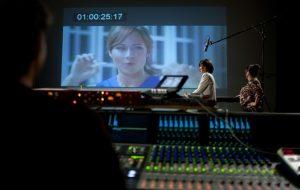
The discipline of bringing to life in French a character who speaks a foreign language in a film or video game.
It's extremely technical and difficult, with lip-sync (lipsync in English), a rhythm track to be followed to the nearest tenth of a second, while keeping to the character's intention, so that the viewer or player doesn't get the impression that the character is... (badly) dubbed, but that French is the character's original language.
Some voice-overs are excellent in dubbing and mediocre in advertising, while others are fantastic in advertising and make poor dubbing actors - don't get me wrong, they're different jobs.
Usage fee:
Known as 'neighbouring rights' in the law, or 'usage fees' in English, these are fees paid by the customer to acquire a licence to use your voice publicly. This licence is specific in terms of territory, duration and type of broadcast. Depending on the country where the project is to be broadcast, it may involve royalties or a buy-out.
Drop-in
cf. Transplanting
Equalisation
(Equalisation or EQ) Modifying the sound signal by attenuating or amplifying certain frequencies (bass, medium, treble...) to correct the sound: too much nasality in one voice, a lack of presence in the bass in another...
PLEASE NOTE: we are not sound engineerswho have been trained in their trade for several years. Just because the tools are available in any DAW doesn't mean you can play the sorcerer's apprentice. The best thing to do is to deliver 'raw' (unprocessed sound), and leave it to the professionals.
E-learning
These are learning modules accessible on the web (hence the E). There are two types:
1/ used strictly internally and available on the intranet, aimed at a company's employees, for example, to teach them how to use new software
2/ sold to the general public
The first does not attract any exploitation rights, the second does: you therefore need to find out about the type of project and the type of broadcast in order to draw up a fair quote.
Elements
Assets' are the various elements (!) that make up a film: soundtrack, film, script.
Elision
Direct definition from the Larousse : Deletion of the final vowel element of a word before a word beginning with a vowel or a silent h.
Less strictly, these are the shortcuts we all use in conversation: 'j'me rappelle' instead of 'je me rappelle', for example.
If you're playing a character, or if you're asked to interpret conversationally, don't hesitate. On the other hand, use with caution in advertising, corporate or e-learning.
French Italian German Spanish - the four main languages concerned in location.
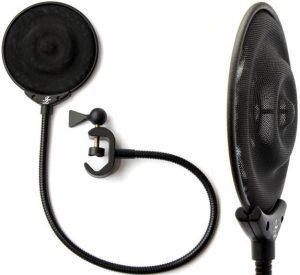
Pop filter
Small screen placed in front of the microphones to help reduce the impact of occlusive consonants on the membranes: the 'pops'. They also protect the membranes from saliva splashes, which reduce their longevity. Windscreens, which muffle the sound, are reserved for radio and TV studios, which are equipped with dynamic microphones.
There are nylon pop filters (think women's tights), foam filters and metal mesh filters. The latter are more acoustically 'transparent' and easier to clean. Be careful not to position them too close to the microphone and to orientate them so that they are not parallel to the membrane - this will avoid standing waves between the membrane and the filter.
During my career, I've worked with dozens of different pop filters, and the best I've been able to find (and that I've adopted in my studio) is the JZ Pop Filter. It doesn't 'sound' like other metal grid pop filters, is small enough not to hide the screen, and thanks to its particular shape, works miracles - no, I don't own any JZ shares, but I should!
In the context of voice-over, English for soap (error on the part of the voice-over actor)
Voice-over training
Some are excellent, many are not, and some are downright scams. One piece of advice I can't repeat often enough: check the credibility, skills and professional background of the trainers. I urge you to read Voice over training, coaching, mentoring, and scamming. And if you'd like to take some training, you'll find what I have to offer on this page voice over coaching.
Network imaging
Continuity' consists of announcing the different programmes on a TV or radio channel. It's a special job and an important role, because it literally means being 'the voice of the channel (or radio station)'. It's a character that is built up with the producer in charge of the package.
There are few chosen ones in this discipline, and I can boast of having been chosen as a channel voice by Discovery, ESPN and Téléfoot during my career. Yes, I'm showing off, but I've got the right - it's my website!
Home studio
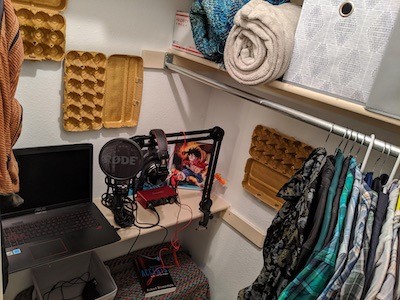 A misnomer that conjures up in the minds of producers and customers a 2-bit microphone in a cupboard with egg cartons stuck to the wall. This is sometimes the case, but in fact it simply refers to a voice over recording studio private. The only thing that separates them from commercial studios is the fact that home studios are private (and therefore not insured to receive the public) and not equipped to process sound: they are used for recording and nothing else. There are good and bad home studios, just as there are good and bad commercial studios. I develop the subject in this article on home studios and voice-over recording.
A misnomer that conjures up in the minds of producers and customers a 2-bit microphone in a cupboard with egg cartons stuck to the wall. This is sometimes the case, but in fact it simply refers to a voice over recording studio private. The only thing that separates them from commercial studios is the fact that home studios are private (and therefore not insured to receive the public) and not equipped to process sound: they are used for recording and nothing else. There are good and bad home studios, just as there are good and bad commercial studios. I develop the subject in this article on home studios and voice-over recording.
Infommercial
Film promoting a product, typically shown on teleshopping channels.
In short, sound engineer - this is the person on the other side of the booth, the control room, who is in charge of the technical quality of the recording. Not just anyone can be a sound engineer: they study for several years to acquire their skills. And they have bionic ears. Yes, they do.
The sound engineer is your best friend, treat him as such. If he interrupts a take, it's not to annoy you, he has a good reason, technical or otherwise - resume without fuss, with grace and gratitude.
If you work in a commercial studio, never touch the microphone, it's a cardinal sin. Seriously, NEVER. If it prevents you from seeing your script properly, tell him, he'll be happy to replace it.
Corporate
Corporate. This genre covers a wide range of projects: web spots, corporate films, industrial films, etc.
Not to be confused with acoustic treatment. Soundproofing a studio theoretically ensures that sound from outside does not enter inside, and vice versa. Excellent soundproofing is essential for any professional recording studio, unless it's located in a perfectly silent place - the desert, for example. Or the moon, perhaps.
Lipsync
In French, (post)lip synchonisation.
Audiobook' needs no explanation. If you're interested in the subject - and it's a beautiful one - you'll find an article on the audio book, its codes, its requirements, here.
Reversioning' in English (in the context of voice-over). This is the adaptation of a project (usually in English) into foreign languages, often the FIGS.
Acronym for Music & Effects - English for soundtrack (but speechless)
A less sexy subject than others, marketing is nonetheless a must for anyone who wants to make a living from their profession. Contrary to what some people who are allergic to work think, marketing is not a dirty word. I talk about it in my article Voice Over Marketing? Say what?
Micro
A microphone is a device that converts sound waves into electrical impulses. There are different types of microphone, the most commonly used in voice-over applications being the condenser microphone, for its sensitivity and extremely low signal-to-noise ratio (for good quality microphones, of course).
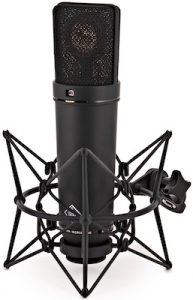
The microphone is an investment that should be considered after many others, including the acoustic treatment, l'sound insulation... and solid training. In this article on voice-over training and this page presents the voice-over training courses I offer.
A high-end microphone such as the Neumann U87which costs around €2,800 with shock-absorbing suspension, is extremely sensitive and therefore requires an impeccable acoustic environment. It will not sound as good as a Røde NT1 250 (including its shock-absorbing suspension) in a less than perfect acoustic environment.
On the other hand, there is no such thing as THE best mic, and rather than investing in a mic for the status it offers, it's better to choose the mic that will best match your voice. Note that a microphone that magnifies a voice is desirable when you're singing, but may be 'too much' for a voice-over application: you don't want to hear your voice, you want to hear what it's saying.
Finally, a microphone is not a magic wand. No microphone will turn an amateur voice-over actor into a professional: a professional's performance on a €200 microphone will always be better than that of an amateur on a €12,000 microphone.
I covered the subject - and the fascination of many voiceover actors with gadgets - in The Microphone, That Obscure Object Of Desire.
An exercise in combining different audio elements: music, effects and voice. It's a job, and it's not our job as voice-over actors. sound engineerswho have studied to acquire extremely advanced skills and develop bionic ears.
Monitors
Also known as 'monitoring speakers'. Unlike hi-fi speakers, they are not intended to colour or embellish the sound, so that you can hear the qualities as well as the faults of a recording. They allow you to clean etc. without wearing headphones. It is still recommended that you do a final listening session using headphones.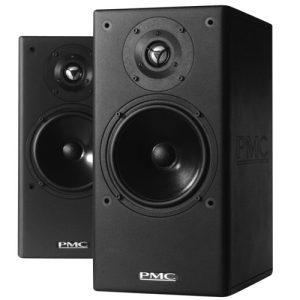
There are proximity monitors, semi-proximity monitors, main monitors... in short, here's an overview of the different types of monitors. excellent audiofanzine article on studio monitors.
Bonus gift: monitors require an acoustic absorption treatment behind them if they are placed close to a wall (and even more so if they are placed in the corners of a room), to avoid parasitic sources.
Audio editing
Edit' - the process by which thesound engineer synchronises the various audio elements and then mixafter cleaned the voice.
Motion design
Yes, it's in French (!) - in English it's called 'explainer'. These are short animated films, rarely lasting more than 90 seconds.
Narration
As the dubbingIt's a separate discipline within the profession. So much so that, for me, it's a very distinct profession. Obviously, as in voice-over, you use your voice and tell a story, but the similarities end there - the codes are different.
In documentaries, there is obviously a time constraint, but in audiobooks, the narrator (with the artistic director if there is one) is in charge, following a brief of course. You have to know how to let yourself go in the text, a practice that is much more complex than it seems.
The action of removing all extraneous noise from a building. plugsuch as mouth noises, etc. Are breaths interfering noises? Yes, when the voice has to be mixed with a soundtrackIn audiobooks, for example, where the voice is usually the only one, it's not (as long as it's not 'dirty'). I discuss this at greater length in my Audio Books, Let's talk about it. Not to be confused with Download.
A process in audio post-production which consists of increasing the peak level of a take in order to achieve consistency of level between different takes.
Overdub
cf. Voice-over
Pass
In video games and dubbing, this is the plug a line.
POS
Point of Sale (POS). POS distribution attracts specific exploitation rights. Consult my price list voice-over for more details.
Pick-up
cf. Transplanting
Playback
Replay a take after it has been recorded.
Voice-over portal
Showcase website where, in exchange for a subscription, voice-over actors have a profile with demos enabling customers either to cast directly from these profiles, or to send a casting to all the people matching the profile they are looking for.
In the plethora of existing portals, there is plenty to eat and drink. There are few serious ones, and many, including some very well-known ones, that are - quite literally - scams. Caveat emptor.
Microphone preamp
The preamplifier is a device that amplifies the low-level signal delivered by the microphones to obtain a line-level signal that can be used by a sound card. It can also be used to colour the sound produced. Some examples are the Avalon VT-737SP (that's mine), the Manley Voxbox or the AMS Neve 8801 which, as well as being preamps, are also equalisers and compressors - they're called channel strips.
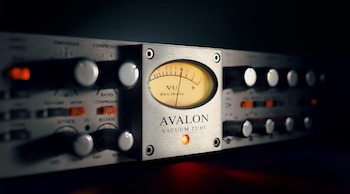 I recommend that you do not use the equaliser and compressor functions, partly because they require the skills ofsound engineer that we don't have as voice-over actors, and secondly, because it's preferable to leave the sound raw so that the sound engineer who does the post-production can be free to work on the sound as he or she sees fit.
I recommend that you do not use the equaliser and compressor functions, partly because they require the skills ofsound engineer that we don't have as voice-over actors, and secondly, because it's preferable to leave the sound raw so that the sound engineer who does the post-production can be free to work on the sound as he or she sees fit.
These console slices are substantial investments, costing between 3,000 and 5,000 euros. Are they desirable? Yes, without a doubt, because they offer more detail and finesse than the preamp built into a sound card. Are they essential? No - the preamps built into current sound cards are more than sufficient for voice-over applications. I can guarantee you that no customer will say to you "your preamp isn't great" if your sound card is of high quality.
Music created by words. It is unique to each of us. Not to be confused with Range.
Take in English. An interpretation by the voice-over actor. Sessions usually involve several takes requested by the director. artistic directorthe producer or the client during sessions where they are present, or the actor if he is self-directing following a brief if he is recording from his private studio.
A recording technique during which, when there is a mistake, the actor stops and picks up where he made the mistake by recording over it, often with a pre-roll.
Called pick-up in English, this involves re-recording part of the script, which will be set by thesound engineer. The term 'drop-in' is used if the patching is done inside an existing socket, rather than following it (pick-up).
(Bleed or spill Sound leakage from the headphones into the microphone - compulsory rewiring!
Resume after an error without stopping recording.
 Social networks
Social networks
Of course you know what it is, so why is it in this glossary? Because it's now an essential tool for developing your business as a voice-over artist - I explain why and how in this article on Voice Over And Social Networks.
Retake
Sometimes the client asks for a new take, following a change in brief for example: this is called a retake.
Rock'n'Roll (or straight through)
A recording technique in which a take is repeated directly without stopping the recording (re-re). Errors are marked by a clicker, making it easy to find the wrong shots at the end of each chapter, for example, in shuffle mode.
A mistake made by the actor during the recording - fluff in English.
Signature
Also known as the endline, tagline or sometimes (incorrectly) claim, it's the sentence that ends a spot. It's a summary of the spot at the same time as its ending, so you have to manage to set a tone that makes it stand out while remaining within the continuation of the spot (if the same voice-over actor does the script and the signature, which is not always the case). This is an exercise in itself, very demanding and extremely difficult to do properly.
Script
Also known as text - it's the story you need to tell, whether it's a TV ad, a corporate film, an on-air package for an e-learning module, a documentary, a character dubbing or an audio book. I covered this subject in my article Hands Off My Script.
Recording session
It can be done either in a commercial studio or in a private studio. In a commercial studio, all you have to do is arrive on time (i.e. at least 10 minutes early), with your voice and body warmed up, and that's it.
In a private studio, the session can either be solo when working on a brief, or a remote session with you in your recording studio on one side and the art director, producer, copywriter or client in the receiving studio on the other. I explained the mechanics of this type of session in detail in my article Remote Recording And Private Studios.
Acronym for Search Engine Optimization. website for search engines, also known as natural or organic referencing.
This term defines all the techniques used to improve a website's ranking on search engine results pages (SERPs). Why talk about SEO in a voice-over dictionary? Because every business needs marketing to function, and a website, and therefore SEO, is an integral part of marketing. marketing.
An acronym for Search Engine Result Page, which refers to the results page of a search engine, displayed after a query has been entered in the search field. A well-optimised, well-constructed website built by people whose job it is will have a better chance of appearing at the top of the first SERP than a site made by your cousin Jean-Michel, whose hobby it is.
Acronym for Special EFecTS - sound effects, sound design and everything that is not music in the soundtrack.
An essential tool for any business in the 21st century - I cover the subject in my article The Haberdashery Shop Window.
Recording studio, whether private or commercial. What defines a professional recording studio is the quality of the sound it produces, not its location.
Lip-synchronisation or post-synchronisation
Lipsync in English. An exercise consisting of dubbing in French (for example) a character played on camera by an actor in his original language.
Take
cf. Socket
Talkback
A function which, at the touch of a button on thesound engineer communicate from the control room with the voice-over actor in the speak booth.
Rates
There are different ways of charging depending on the nature of a project: by the studio hour, by the session, by the finished minute, by the finished hour, by the word - not forgetting the exploitation rights that may apply, again depending on the project. I invite you to visit my Voice Over RatesThis will give you an idea of the different scenarios that can be encountered, and the prices charged by professionals.
Also called register. In voice, this is the range of sounds that can be produced by a person. Not to be confused with Prosody.
Men (bass to treble)
- bass
- baritone
- tenor
- countertenor
Women (low to high)
- Contralto and alto
- mezzo alto
- mezzo-soprano
- soprano
Timecode
In short, TC. The timecode is a reference expressed in hours, minutes, seconds and frames, used for synchronisation and marking of recorded material. The timecode is printed on a working copy of the film.

Not to be confused with sound insulation. Acoustic treatment is an extremely complex and sometimes entirely counter-intuitive art; in other words, it can't be improvised, it has to be studied.
Good acoustic treatment involves a skilful blend of different types of treatment: absorption, diffusion, reflection and diffraction, strategically placed so as to achieve a sound that is reverb-free but lively, matt but not deaf. In short, I invite you to study the bibles 'Master Handbook of Acoustics' by F. Alton Everest and Ken C. Pohlmann, and 'Home Recording Studio - Build it Like the Pros' by Rod Gervais.
At the cleaning, action de retirer le signal sonore non désiré avant (top) et après (tail) une plug.
TTS
Acronym for Text To Speech (but everyone uses TTS): the ancestor of voice-over AI for Artificial Intelligence.
TTS has long existed in the form of concatenation, which involves combining the syllables of recorded words to automatically form words.
This has evolved with AI technology, which now allows a relatively convincing interpretation of a script by software, an interpretation that is now better than that of a mediocre voice-over actor, but which will never be as human as that of an actor who knows how to inject humanity into his interpretation. I'm talking about the future of voice-over and artificial intelligence here.
Today, in 2022, it is a source of concern for some colleagues as to the future of our profession, which is already being replaced by computers. While it's true that this may eventually affect sectors that don't require human interpretation with intention and emotion, only those actors who are incapable of adding value through their ability to absorb a complex brief and offer interpretations that exceed expectations have a lot to worry about. I talk about this human approach to acting in my article A Plea For Imperfection.
The day when a computer can imitate all the nuances of the human voice, it will also be able to replace many other things, but if that happens one day, survival in the face of robots in the service of occult powers will be a more topical subject than voice-overs...
UN style
cf. Voice-over
In French, the term 'voice-over' refers to recording in French over the voice recorded in the original language of the project. In British English, this is called overdub. In American English, it's called UN style.
Voice over in English. Voice over covers many disciplines: commercialsdubbing and characters for animations, video games, etc., corporate filmsnarration of documentaries and audio books, audio description, network imagingpodcast...
If I've missed any terms, let me know by commenting on this article, and I'll update this voiceover dictionary. As always, if you find it useful, remember to share it with colleagues in your network who might also find it interesting - they'll be grateful, and so will I.
PS: by subscribing to this voice over blog, you will have exclusive access to new articles before they are officially published. It's free so make the most of it, subscribe now !
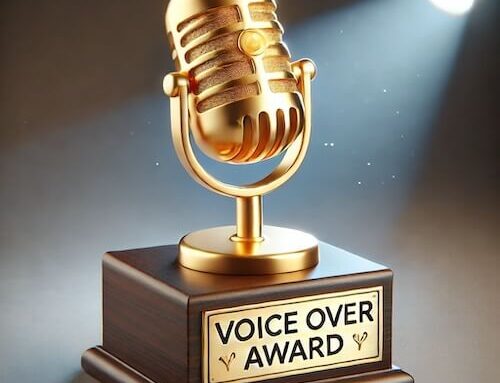




Thank you for all your valuable information
You're welcome Flo!
Thank you for this very specific and instructive glossary.
We'd love to!